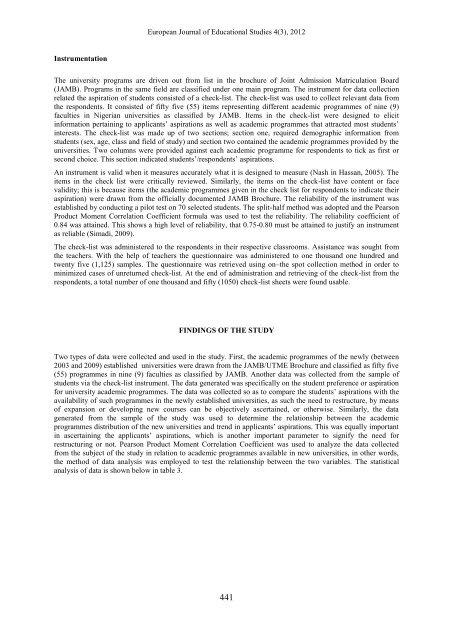Volume 4 Issue 3 (October 2012) - Ozean Publications
Volume 4 Issue 3 (October 2012) - Ozean Publications
Volume 4 Issue 3 (October 2012) - Ozean Publications
Create successful ePaper yourself
Turn your PDF publications into a flip-book with our unique Google optimized e-Paper software.
European Journal of Educational Studies 4(3), <strong>2012</strong><br />
Instrumentation<br />
The university programs are driven out from list in the brochure of Joint Admission Matriculation Board<br />
(JAMB). Programs in the same field are classified under one main program. The instrument for data collection<br />
related the aspiration of students consisted of a check-list. The check-list was used to collect relevant data from<br />
the respondents. It consisted of fifty five (55) items representing different academic programmes of nine (9)<br />
faculties in Nigerian universities as classified by JAMB. Items in the check-list were designed to elicit<br />
information pertaining to applicants’ aspirations as well as academic programmes that attracted most students’<br />
interests. The check-list was made up of two sections; section one, required demographic information from<br />
students (sex, age, class and field of study) and section two contained the academic programmes provided by the<br />
universities. Two columns were provided against each academic programme for respondents to tick as first or<br />
second choice. This section indicated students’/respondents’ aspirations.<br />
An instrument is valid when it measures accurately what it is designed to measure (Nash in Hassan, 2005). The<br />
items in the check list were critically reviewed. Similarly, the items on the check-list have content or face<br />
validity; this is because items (the academic programmes given in the check list for respondents to indicate their<br />
aspiration) were drawn from the officially documented JAMB Brochure. The reliability of the instrument was<br />
established by conducting a pilot test on 70 selected students. The split-half method was adopted and the Pearson<br />
Product Moment Correlation Coefficient formula was used to test the reliability. The reliability coefficient of<br />
0.84 was attained. This shows a high level of reliability, that 0.75-0.80 must be attained to justify an instrument<br />
as reliable (Simadi, 2009).<br />
The check-list was administered to the respondents in their respective classrooms. Assistance was sought from<br />
the teachers. With the help of teachers the questionnaire was administered to one thousand one hundred and<br />
twenty five (1,125) samples. The questionnaire was retrieved using on–the spot collection method in order to<br />
minimized cases of unreturned check-list. At the end of administration and retrieving of the check-list from the<br />
respondents, a total number of one thousand and fifty (1050) check-list sheets were found usable.<br />
FINDINGS OF THE STUDY<br />
Two types of data were collected and used in the study. First, the academic programmes of the newly (between<br />
2003 and 2009) established universities were drawn from the JAMB/UTME Brochure and classified as fifty five<br />
(55) programmes in nine (9) faculties as classified by JAMB. Another data was collected from the sample of<br />
students via the check-list instrument. The data generated was specifically on the student preference or aspiration<br />
for university academic programmes. The data was collected so as to compare the students’ aspirations with the<br />
availability of such programmes in the newly established universities, as such the need to restructure, by means<br />
of expansion or developing new courses can be objectively ascertained, or otherwise. Similarly, the data<br />
generated from the sample of the study was used to determine the relationship between the academic<br />
programmes distribution of the new universities and trend in applicants’ aspirations. This was equally important<br />
in ascertaining the applicants’ aspirations, which is another important parameter to signify the need for<br />
restructuring or not. Pearson Product Moment Correlation Coefficient was used to analyze the data collected<br />
from the subject of the study in relation to academic programmes available in new universities, in other words,<br />
the method of data analysis was employed to test the relationship between the two variables. The statistical<br />
analysis of data is shown below in table 3.<br />
441

















